Superorder Decapodiformes | ||
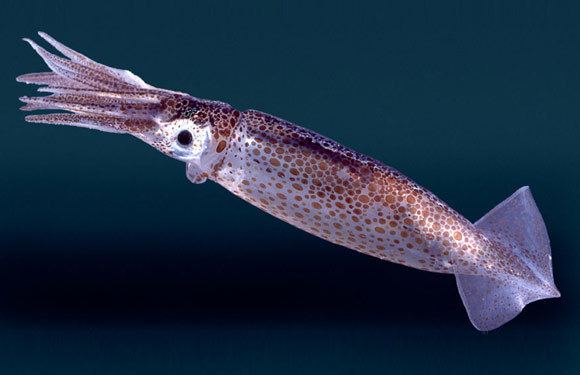 | ||
Similar Squid as food, Cuttlefish, Crab, Clam, Oyster | ||
You re not hallucinating that s just squid skin deep look
Squid are cephalopods of the order Teuthida, which comprises around 304 species. Like all other cephalopods, squid have a distinct head, bilateral symmetry, a mantle, and arms. Squid, like cuttlefish, have eight arms arranged in pairs and two, usually longer, tentacles. Squid are strong swimmers and certain species can "fly" for short distances out of the water.
Contents
- You re not hallucinating that s just squid skin deep look
- Taxonomy
- Evolution
- Description
- Nervous system
- Reproductive system
- Digestive system
- Cardiovascular system
- Head
- Size
- Commercial fishing
- As food
- References
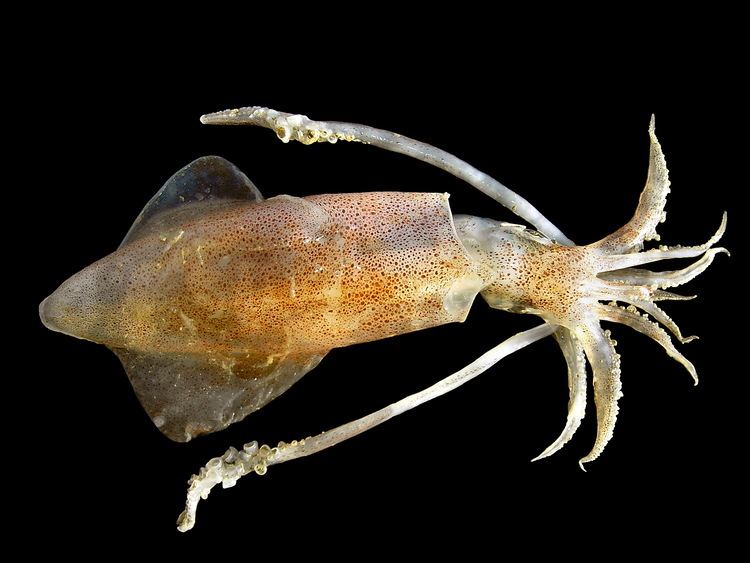
Taxonomy
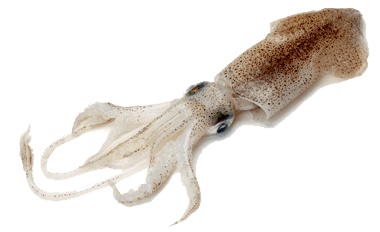
Squid are members of the class Cephalopoda, subclass Coleoidea, order Teuthida, which has two major suborders, Myopsina and Oegopsina (including giant squid such as Architeuthis dux). Teuthida is the largest cephalopod order with around 300 species classified into 29 families.
The order Teuthida is a member of the superorder Decapodiformes (from the Greek for "ten legs"). Two other orders of decapodiform cephalopods are also called squid, although they are taxonomically distinct from Teuthida and differ recognizably in their gross anatomical features. They are the bobtail squid of order Sepiolida and the ram's horn squid of the monotypic order Spirulida. The vampire squid, however, is more closely related to the octopuses than to any squid.
Evolution
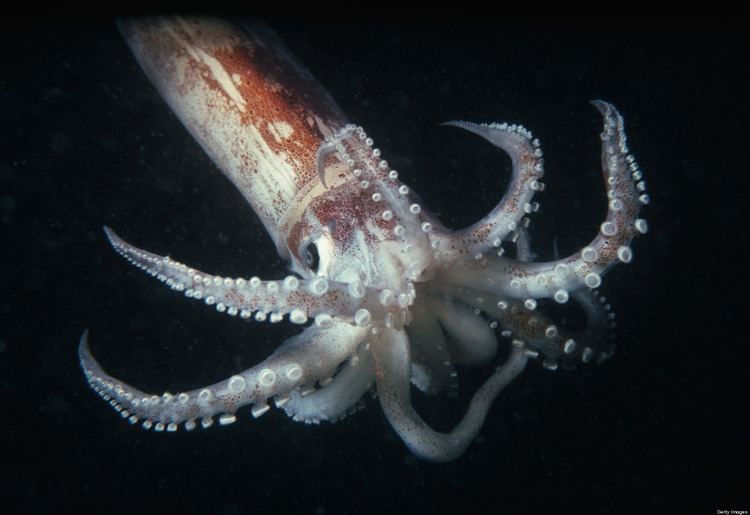
Squid have differentiated from their ancestral molluscs such that the body plan has been condensed antero-posteriorly and extended dorso-ventrally. What before may have been the foot of the ancestor is modified into a complex set of tentacles and highly developed sense organs, including advanced eyes similar to those of vertebrates.
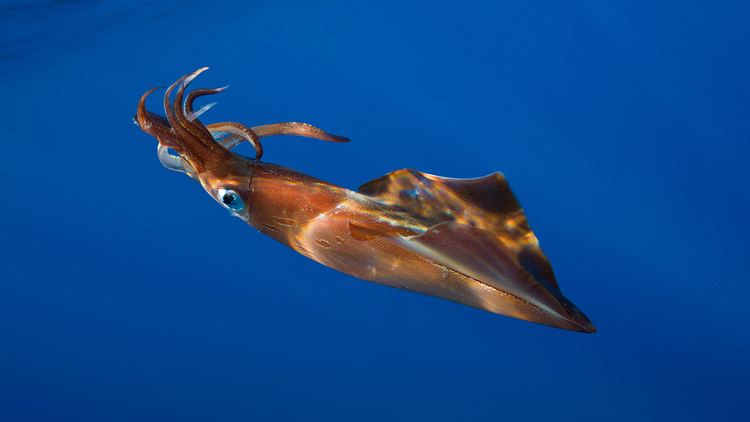
The ancestral shell has been lost, with only an internal gladius, or pen, remaining. The pen is a feather-shaped internal structure that supports the squid's mantle and serves as a site for muscle attachment. It is made of a chitin-like material.
Description
The main body mass is enclosed in the mantle, which has a swimming fin along each side. These fins, unlike in other marine organisms, are not the main source of locomotion in most species.
The skin is covered in chromatophores, which enable the squid to change color to suit its surroundings, making it practically invisible. The underside is also almost always lighter than the topside, to provide camouflage from both prey and predator.
Under the body are openings to the mantle cavity, which contains the gills (ctenidia) and openings to the excretory and reproductive systems. At the front of the mantle cavity lies the siphon, which the squid uses for locomotion via precise jet propulsion. In this form of locomotion, water is sucked into the mantle cavity and expelled out of the siphon in a fast, strong jet. The direction of the siphon can be changed, to suit the direction of travel.
Inside the mantle cavity, beyond the siphon, lies the visceral mass, which is covered by a thin, membranous epidermis. Under this are all the major internal organs.
Nervous system
The giant axon, which may be up to 1 mm (0.04 in) in diameter in some larger species, innervates the mantle and controls part of the jet propulsion system.
As cephalopods, squid exhibit relatively high intelligence among invertebrates. For example, groups of Humboldt squid hunt cooperatively, using active communication. (See Cephalopod intelligence.)
Reproductive system
In females, the ink sac is hidden from view by a pair of white nidamental glands, which lie anterior to the gills. Also, red-spotted accessory nidamental glands are present. Both organs are associated with nutrient manufacture and shells for the eggs. Females also have a large translucent ovary, situated towards the posterior of the visceral mass.
Males do not possess these organs, but instead have a large testis in place of the ovary, and a spermatophoric gland and sac. In mature males, this sac may contain spermatophores, which are placed inside the female's mantle during mating.
Shallow-water species of the continental shelf and epipelagic/mesopelagic zones are characterised by the presence of hectocotyli, specially modified arms used to fertilise the female's eggs. Most deep-sea squid lack hectocotyli and have longer penises; Ancistrocheiridae and Cranchiinae are exceptions. Giant squid of the genus Architeuthis are unusual in that they possess both a large penis and modified arm tips, although whether the latter are used for spermatophore transfer is uncertain. Penis elongation has been observed in the deep-water species Onykia ingens; when erect, the penis may be as long as the mantle, head, and arms combined. As such, deep-water squid have the greatest known penis length relative to body size of all mobile animals, second in the entire animal kingdom only to certain sessile barnacles.
Digestive system
Like all cephalopods, squid have complex digestive systems. The muscular stomach is found roughly in the midpoint of the visceral mass. From there, the bolus moves into the caecum for digestion. The caecum, a long, white organ, is found next to the ovary or testis. In mature squid, more priority is given to reproduction such that the stomach and caecum often shrivel up during the later life stages. Finally, food goes to the liver (or digestive gland), found at the siphon end, for absorption. Solid waste is passed out of the rectum. Beside the rectum is the ink sac, which allows a squid to rapidly discharge black ink into the mantle cavity.
Cardiovascular system
Squid have three hearts. Two branchial hearts feed the gills, each surrounding the larger systemic heart that pumps blood around the body. Squid blood contains the copper-rich protein hemocyanin for transporting oxygen. The faintly greenish hearts are surrounded by the renal sacs - the main excretory system. The kidneys are difficult to identify and stretch from the hearts (located at the posterior side of the ink sac) to the liver. The systemic heart is made of three chambers, a lower ventricle and two upper auricles.
Head
The head end bears eight arms and two tentacles, each a form of muscular hydrostat containing many suckers along the edge. These tentacles do not grow back if severed. In the mature male, one basal half of the left ventral tentacle is hectocotylised—and ends in a copulatory pad rather than suckers. It is used for sexual intercourse.
The mouth is equipped with a sharp, horny beak mainly made of chitin and cross-linked proteins, and is used to kill and tear prey into manageable pieces. The beak is very robust, but does not contain minerals, unlike the teeth and jaws of many other organisms, including marine species. Captured whales often have indigestible squid beaks in their stomachs. The mouth contains the radula (the rough tongue common to all molluscs except bivalvia).
The eyes, on either side of the head, each contain a hard lens. The image is focused by changing the position of the lens, as in a camera or telescope, rather than changing the shape of the lens, as in the human eye.
Squid appear to have limited hearing.
Size
The majority are no more than 60 cm (24 in) long, although the giant squid may reach 13 m (43 ft).
In 1978, sharp, curved claws on the suction cups of squid tentacles cut up the rubber coating on the hull of the USS Stein. The size suggested the largest squid known at the time.
In 2003, a large specimen of an abundant but poorly understood species, Mesonychoteuthis hamiltoni (the colossal squid), was discovered. This species may grow to 14 m (46 ft) in length, making it the largest invertebrate. Squid have the largest eyes in the animal kingdom. The kraken is a legendary tentacled monster possibly based on sightings of real giant squid.
In February 2007, a New Zealand fishing vessel caught a colossal squid weighing 495 kg (1,091 lb) and measuring around 10 m (33 ft) off the coast of Antarctica. This specimen represents the largest cephalopod to ever be scientifically documented.
Commercial fishing
According to the FAO, the cephalopod catch for 2002 was 3,173,272 tonnes (6.995867×109 lb). Of this, 2,189,206 tonnes, or 75.8 percent, was squid. The following table lists the squid species fishery catches which exceeded 10,000 tonnes (22,000,000 lb) in 2002.
As food
Many species are popular as food in cuisines as diverse as American, Basque, Canadian, Chinese, English, Filipino, Greek, Italian, Japanese, Korean, Portuguese, Spanish, Tunisian, Turkish and Vietnamese.
In English-speaking countries, squid as food is often marketed using the Italian word calamari. Squid are found abundantly in certain areas, and provide large catches for fisheries. The body can be stuffed whole, cut into flat pieces, or sliced into rings. The arms, tentacles, and ink are also edible; in fact, the only parts not eaten are the beak and gladius (pen). Squid is a good food source for zinc and manganese, and high in copper, selenium, vitamin B12, and riboflavin.
